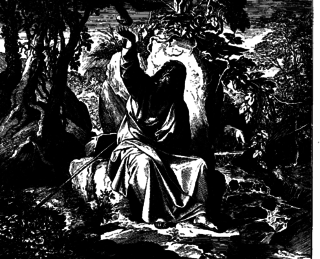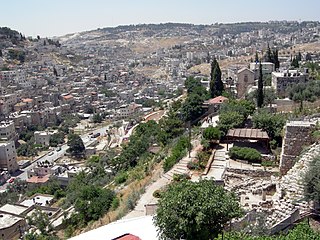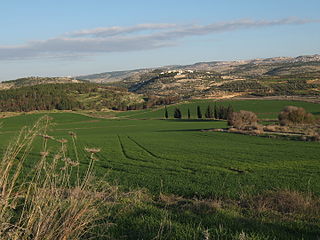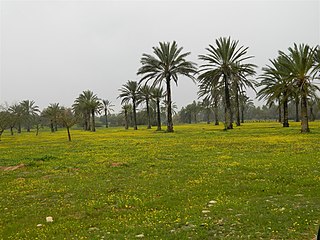
The Jordan River or River Jordan, also known as Nahr Al-Sharieat, is a 251-kilometre-long (156 mi) river in the Middle East that flows roughly north to south through the Sea of Galilee and on to the Dead Sea. Jordan and the Golan Heights border the river to the east, while Palestine's West Bank and Israel lie to its west. Both Jordan and the West Bank take their names from the river.

Philistia was a confederation of five main cities or pentapolis in the Southwest Levant, made up of principally Gaza, Ashkelon, Ashdod, Ekron, and Gath, and for a time, Jaffa.
Mizraim is the Hebrew and Aramaic name for the land of Egypt and its people. It is ascribed to one of the sons of the Biblical figure Ham.

ʻArish or el-ʻArīsh is the capital and largest city of the North Sinai Governorate of Egypt, as well as the largest city on the Sinai Peninsula, lying on the Mediterranean coast 344 kilometres (214 mi) northeast of Cairo and 45 kilometres (28 mi) west of the Egypt-Gaza border.

Cherith, Kerith, or sometimes Chorath, is the name of a wadi, or intermittent seasonal stream mentioned in the Hebrew Bible. The prophet Elijah hid himself on the banks of the Cherith and was fed by ravens during the early part of the three years' drought which he announced to King Ahab.
Rhinocorura or Rhinocolura was the name of a region and associated town and rivers lying between Ancient Egypt and the Land of Israel. The name may refer explicitly to:

Chumash is a Torah in printed and book bound form as opposed to a Sefer Torah, which is a scroll.

A Mikraot Gedolot, often called the "Rabbinic Bible" in English, is an edition of the Hebrew Bible that generally includes three distinct elements:

Kidron Valley is the modern name of the valley originating slightly northeast of the Old City of Jerusalem, which then separates the Temple Mount from the Mount of Olives, and ending at the Dead Sea. Beyond Jerusalem it continues in a general south-easterly direction through the Judean desert in the West Bank, reaching the Dead Sea near the settlement of Ovnat, and descending 4,000 feet (1,200 m) along its 20-mile (32 km) course.
Hebrew Bible English translations are English translations of the Hebrew Bible (Tanakh) according to the Masoretic Text, in the traditional division and order of Torah, Nevi'im, and Ketuvim. Most Jewish translations appear in bilingual editions (Hebrew–English).
Jewish commentaries on the Bible are biblical commentaries of the Hebrew Bible from a Jewish perspective. Translations into Aramaic and English, and some universally accepted Jewish commentaries with notes on their method of approach and also some modern translations into English with notes are listed.

The Besor or Wadi Gaza is a wadi in southern Israel and Palestine. The stream begins at Mount Boker, and spills into the Mediterranean Sea near Al-Zahra in the Gaza Strip. Further upstream it was marked as Wadi esh-Shallaleh on the 1878 Survey of Western Palestine map. The area has several important archaeological sites.
"Pele-joez-el-gibbor-abi-ad-sar-shalom" is a prophetic name or title which occurs in Isaiah 9:5 in the Hebrew Bible or Isaiah 9:6 in English Bibles. It is one of a series of prophetic names found in chapters 7, 8 and 9 of the Book of Isaiah, including most notably Immanuel "God with us", and Maher-shalal-hash-baz - "He has made haste to the plunder!" - in the previous chapter, which is a reference to the impending plunder of Samaria and Damascus by the king of Assyria.

The Land of Israel is the traditional Jewish name for an area of the Southern Levant. Related biblical, religious and historical English terms include the Land of Canaan, the Promised Land, the Holy Land, and Palestine. The definitions of the limits of this territory vary between passages in the Hebrew Bible, with specific mentions in Genesis 15, Exodus 23, Numbers 34 and Ezekiel 47. Nine times elsewhere in the Bible, the settled land is referred as "from Dan to Beersheba", and three times it is referred as "from the entrance of Hamath unto the brook of Egypt".

Eshkol National Park is a national park located in Northern Negev, Israel, near Gaza.

Nahal Gerar, also Nachal Grar is a wadi in Israel, in the Negev desert. Its Arabic name is Wadi esh-Sheri'a. Along this wadi, there are several important ancient Bronze Age archaeological sites. During the Early Iron Age this was an area of Philistine settlement.

1 Chronicles 13 is the thirteenth chapter of the Books of Chronicles in the Hebrew Bible or the First Book of Chronicles in the Old Testament of the Christian Bible. The book is compiled from older sources by an unknown person or group, designated by modern scholars as "the Chronicler", and had the final shape established in late fifth or fourth century BCE. This chapter contains the account of an unsuccessful attempt to bring the ark of the covenant to Jerusalem by David. The whole chapter belongs to the section focusing on the kingship of David.

Nadav Na'aman is an Israeli archaeologist and historian. He specializes in the study of Near East in the second and first millenniums BC. His research combines the history of the Ancient Near East, archaeology, Assyrology, and the study of the Bible. He possesses broad knowledge in all these four branches of research.












